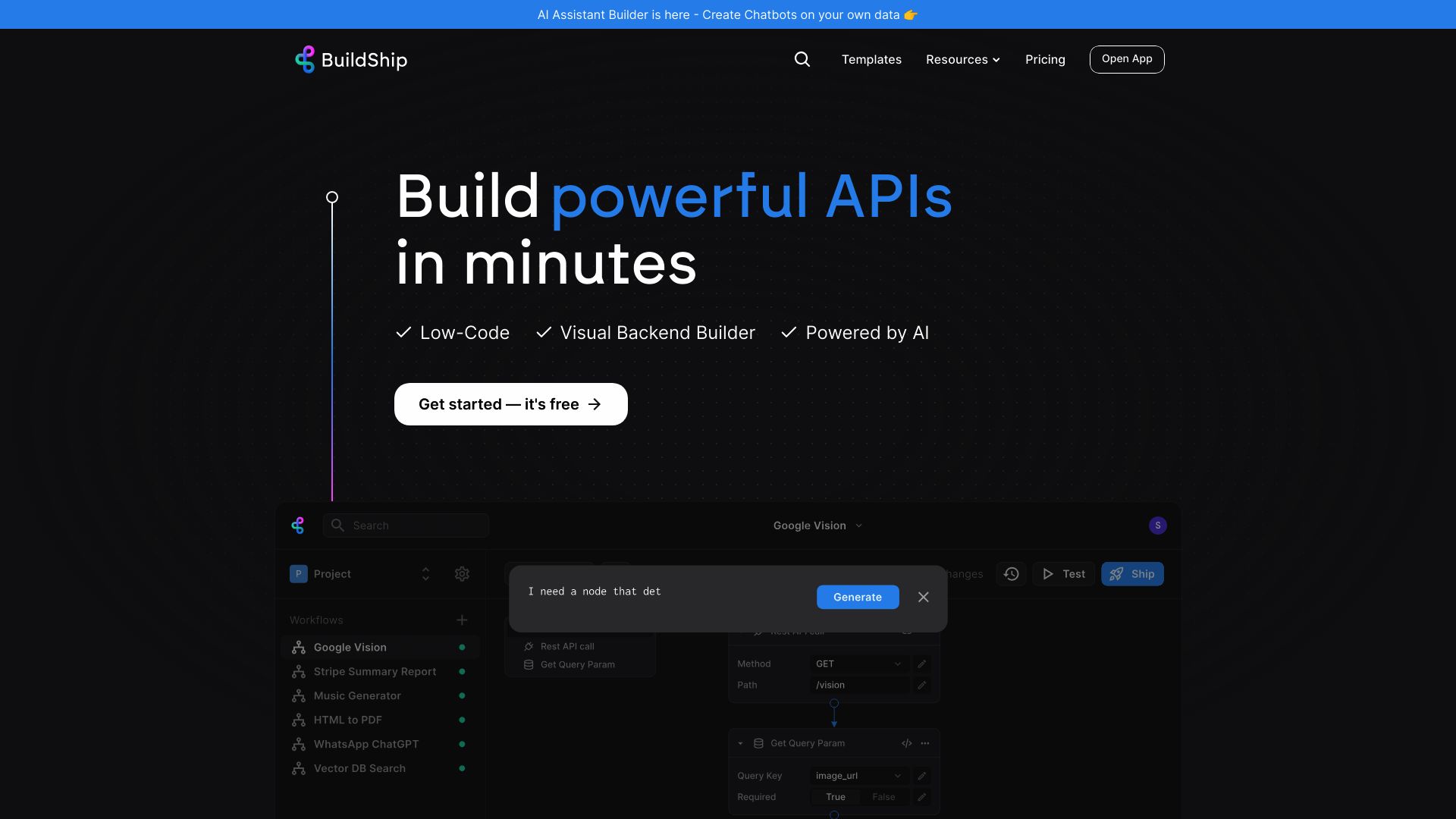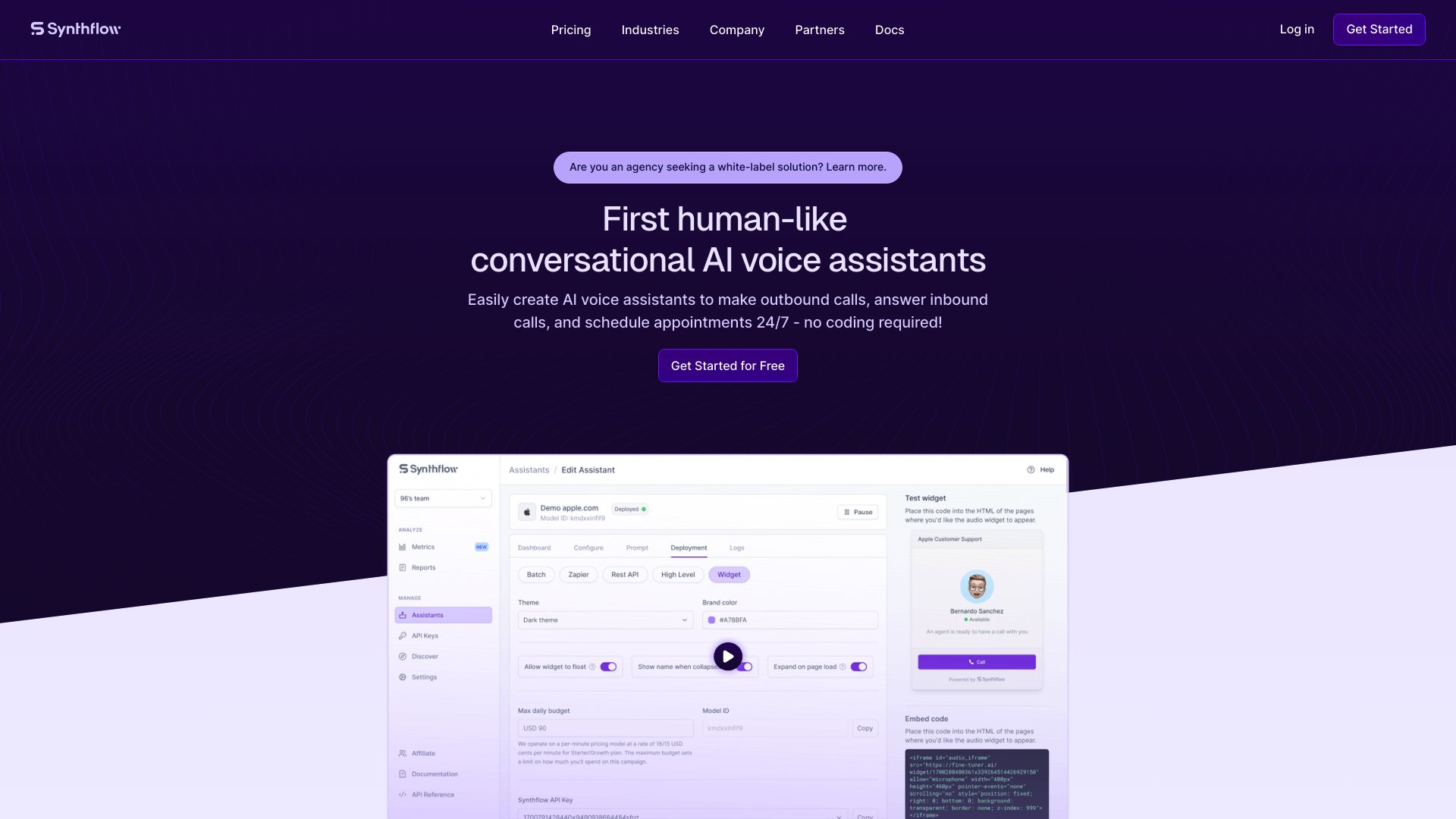BuildShip vs. Synthflow: Comparing AI Development Platforms
AI-powered development platforms are revolutionizing the way businesses create and deploy intelligent applications. BuildShip vs. Synthflow offer unique approaches to this challenge, each with distinct strengths and limitations. This comparison delves into the core features, development processes, and deployment options of both platforms, while introducing SmythOS as a comprehensive alternative.
We’ll explore how these tools cater to different user needs, from no-code enthusiasts to seasoned developers, and examine their potential impact on various industries. Whether you’re a startup looking to rapidly prototype AI solutions or an enterprise seeking to scale complex workflows, this analysis will help you navigate the landscape of AI development platforms and choose the best fit for your project.
BuildShip Overview
BuildShip empowers developers to create scalable backend workflows and APIs without extensive coding. The platform’s visual no-code interface simplifies the process of building complex backend systems, integrating AI models, and deploying production-ready applications.
BuildShip’s drag-and-drop workflow builder stands out with its ability to generate custom nodes using AI. This feature allows users to describe desired functionality in natural language, streamlining the development process. The platform seamlessly integrates various data sources, APIs, and AI models, enabling the creation of sophisticated workflows tailored to specific business needs.
BuildShip’s drag-and-drop workflow builder stands out with its ability to generate custom nodes using AI… streamlining the development process.


Developers appreciate BuildShip’s flexibility in customization. While the visual interface caters to no-code users, the platform allows for fine-tuning in JavaScript or TypeScript. This hybrid approach bridges the gap between visual development and code-level control, accommodating a wide range of user preferences and project requirements.
While the visual interface caters to no-code users, the platform allows for fine-tuning in JavaScript or TypeScript.
BuildShip’s deployment options enhance its utility for production environments. Users can transform their workflows into scalable APIs, integrate them into existing applications, or schedule automated runs. The platform leverages Google Cloud Platform for serverless deployments, ensuring reliability and scalability. However, BuildShip’s reliance on GCP may limit options for users preferring alternative cloud providers.
Security remains a priority for BuildShip, with features like OAuth integration and secure API key storage using Google Cloud Secret Manager. While these measures provide a solid foundation, the platform could benefit from more advanced security options to meet enterprise-level requirements fully.
Synthflow Overview
Synthflow empowers businesses to create customizable AI voice assistants without coding expertise. The platform’s no-code interface and pre-built templates make advanced AI technology accessible to users of all technical backgrounds.


Synthflow excels in developing AI assistants for customer support, lead generation, and appointment scheduling. The platform offers unlimited secure storage in a dedicated Pinecone environment, ensuring data privacy and compliance. Integration capabilities with tools like 11Labs and Twilio enhance functionality and extend the assistants’ capabilities.
Synthflow empowers businesses to create customizable AI voice assistants without coding expertise. The platform’s no-code interface and pre-built templates make advanced AI technology accessible to users of all technical backgrounds.
The visual builder simplifies the creation process, allowing users to design AI agents with distinct personalities aligned with their brand. Synthflow supports both batch deployments for large-scale communication campaigns and real-time interactions through website widgets, catering to diverse business needs.
While Synthflow provides a user-friendly experience, it lacks some advanced features found in other platforms. The absence of a dedicated debug mode and limited customization options for experienced developers may restrict its appeal to more technical users. Additionally, the platform does not offer hosted vector databases or specialized crawling capabilities, which could limit its application in certain data-intensive scenarios.
Synthflow positions itself as a solution for businesses seeking to leverage AI for improved customer engagement and operational efficiency. Its focus on accessibility and ease of use makes it particularly attractive to non-technical users and small to medium-sized enterprises looking to incorporate AI into their customer service strategies.
Feature Comparison
BuildShip and Synthflow offer distinct approaches to AI agent development, with notable differences in their core components and security features. BuildShip provides a robust visual backend builder for creating scalable APIs and workflows, integrating various AI models and data sources. Its drag-and-drop interface, coupled with AI-powered node generation, streamlines the development process for users of all technical levels. BuildShip excels in customization, allowing fine-tuning in JavaScript or TypeScript, bridging visual development and code-level control.
Synthflow focuses on creating AI voice assistants without coding, emphasizing ease of use for non-technical users. While both platforms offer no-code options, Synthflow’s pre-built templates for customer support and lead generation cater to specific business needs. BuildShip’s integration with foundation AI models and APIs provides more extensive customization possibilities, whereas Synthflow’s integration focuses on voice-related technologies like 11Labs and Twilio. In terms of security,
BuildShip leverages Google Cloud Secret Manager for API key storage, while Synthflow offers unlimited secure storage in a dedicated Pinecone environment. BuildShip’s deployment options and scalability through Google Cloud Platform provide an edge for users requiring more complex, production-grade solutions.
Feature Comparison Table
| BuildShip | Synthflow | SmythOS | |
|---|---|---|---|
| CORE FEATURES | |||
| Memory & Context | ❌ | ✅ | ✅ |
| Autonomous Agents | ❌ | ✅ | ✅ |
| Explainability & Transparency | ❌ | ✅ | ✅ |
| Multimodal | ❌ | ❌ | ✅ |
| Problem-Solving Capabilities | ❌ | ✅ | ✅ |
| Multi-Agent Collaboration | ❌ | ✅ | ✅ |
| Human-AI Interaction | ❌ | ✅ | ✅ |
| Audit Logs for Analytics | ❌ | ✅ | ✅ |
| Work as Team | ❌ | ✅ | ✅ |
| SECURITY | |||
| Constrained Alignment | ❌ | ✅ | ✅ |
| IP Control | ✅ | ❌ | ✅ |
| COMPONENTS | |||
| Foundation AIs | ❌ | ✅ | ✅ |
| Huggingface AIs | ❌ | ❌ | ✅ |
| Zapier APIs | ❌ | ✅ | ✅ |
| Classifiers | ❌ | ❌ | ✅ |
| Data Lakes | ❌ | ❌ | ✅ |
| DEPLOYMENT OPTIONS (EMBODIMENTS) | |||
| Staging Domains | ❌ | ❌ | ✅ |
| Production Domains | ❌ | ❌ | ✅ |
| Deploy as Site Chat | ❌ | ✅ | ✅ |
| Deploy as GPT | ❌ | ✅ | ✅ |
| DATA LAKE SUPPORT | |||
| Hosted Vector Database | ❌ | ✅ | ✅ |
| Sitemap Crawler | ❌ | ✅ | ✅ |
| YouTube Transcript Crawler | ❌ | ✅ | ✅ |
| URL Crawler | ❌ | ❌ | ✅ |
| PDF Support | ❌ | ❌ | ✅ |
| Word File Support | ❌ | ❌ | ✅ |
| TXT File Support | ❌ | ❌ | ✅ |
Best Alternative to BuildShip and Synthflow
SmythOS stands out as the superior alternative to BuildShip and Synthflow for AI agent development. Our platform offers unparalleled flexibility and power, enabling users to create sophisticated AI agents for a wide range of applications. We provide a comprehensive drag-and-drop interface that simplifies complex AI workflows without sacrificing functionality. Unlike BuildShip’s limited backend focus or Synthflow’s niche voice assistant capabilities, SmythOS supports multimodal agents that can handle various data types, including text, images, and more. Our platform excels in multi-agent collaboration and problem-solving, features lacking in both competitors. We offer robust security measures, including constrained alignment and data encryption, ensuring your AI projects remain safe and compliant.
SmythOS stands out as the superior alternative to BuildShip and Synthflow for AI agent development… enabling users to create sophisticated AI agents for a wide range of applications.
With SmythOS, users gain access to an extensive integration ecosystem, connecting to popular services and APIs effortlessly. Our deployment options surpass those of BuildShip and Synthflow, allowing agents to be deployed as APIs, chatbots, or even GPTs. SmythOS also provides unmatched scalability and performance, critical for enterprise-level implementations. By choosing SmythOS, users unlock unlimited use cases and benefit from our cutting-edge features like hosted vector databases and advanced data lake support. Whether you’re a developer, business leader, or AI enthusiast, SmythOS empowers you to harness the full potential of AI agents with unprecedented ease and efficiency.
Conclusion
BuildShip and Synthflow offer unique approaches to AI development, each with distinct strengths. BuildShip excels in backend workflow creation and API development, providing a flexible platform for technical users. Synthflow focuses on accessible AI voice assistant creation, catering to businesses seeking customer engagement solutions without coding expertise.
While both platforms have their merits, SmythOS emerges as the superior choice for businesses and developers seeking a comprehensive AI development solution. Our platform combines the strengths of visual development with extensive customization options, supporting a wide range of AI models and integrations. SmythOS’s ability to deploy agents across multiple platforms, from APIs to chatbots, offers unparalleled versatility.
SmythOS stands out with its robust feature set, including multi-agent collaboration, advanced debugging tools, and seamless integrations with over 300,000 services. Our platform’s emphasis on scalability, security, and transparency makes it ideal for enterprises and startups alike. The combination of no-code accessibility and powerful development tools positions SmythOS as the go-to solution for organizations looking to leverage AI across their operations.
To experience the full potential of AI development and deployment, we invite you to explore our diverse range of AI-powered agent templates. Whether you’re looking to streamline workflows, enhance customer interactions, or build complex AI systems, SmythOS provides the tools and flexibility to bring your vision to life. Create a free SmythOS account today and join the AI revolution, backed by our 30-day money-back guarantee. Unleash the power of AI for your business and discover why SmythOS is the ultimate platform for building the future of intelligent automation.
Last updated:
Disclaimer: The information presented in this article is for general informational purposes only and is provided as is. While we strive to keep the content up-to-date and accurate, we make no representations or warranties of any kind, express or implied, about the completeness, accuracy, reliability, suitability, or availability of the information contained in this article.
Any reliance you place on such information is strictly at your own risk. We reserve the right to make additions, deletions, or modifications to the contents of this article at any time without prior notice.
In no event will we be liable for any loss or damage including without limitation, indirect or consequential loss or damage, or any loss or damage whatsoever arising from loss of data, profits, or any other loss not specified herein arising out of, or in connection with, the use of this article.
Despite our best efforts, this article may contain oversights, errors, or omissions. If you notice any inaccuracies or have concerns about the content, please report them through our content feedback form. Your input helps us maintain the quality and reliability of our information.
